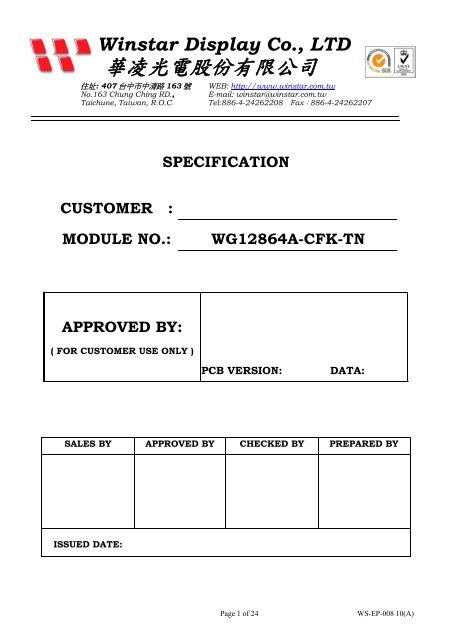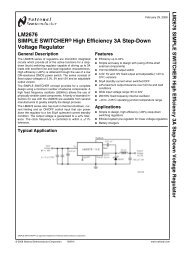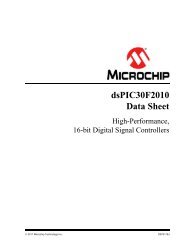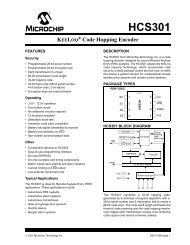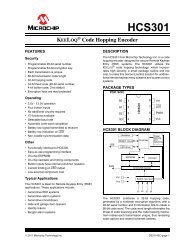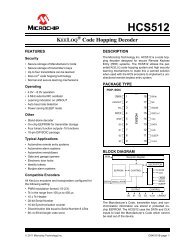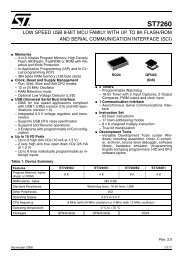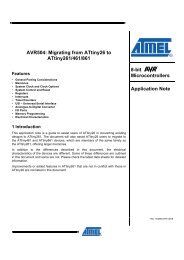華凌光電股份有限公司
華凌光電股份有限公司
華凌光電股份有限公司
Create successful ePaper yourself
Turn your PDF publications into a flip-book with our unique Google optimized e-Paper software.
Winstar Display Co., LTD<br />
華 凌 光 電 股 份 有 限 公 司<br />
住 址 : 407 台 中 市 中 清 路 163 號<br />
No.163 Chung Ching RD.,<br />
Taichune, Taiwan, R.O.C<br />
WEB: http://www.winstar.com.tw<br />
E-mail: winstar@winstar.com.tw<br />
Tel:886-4-24262208 Fax:886-4-24262207<br />
SPECIFICATION<br />
CUSTOMER :<br />
MODULE NO.:<br />
WG12864A-CFK-TN<br />
APPROVED BY:<br />
( FOR CUSTOMER USE ONLY )<br />
PCB VERSION:<br />
DATA:<br />
SALES BY APPROVED BY CHECKED BY PREPARED BY<br />
ISSUED DATE:<br />
Page 1 of 24<br />
WS-EP-008 10(A)
Winstar Display Co., LTD<br />
華 凌 光 電 股 份 有 限 公 司<br />
RECORDS OF REVISION<br />
MODLE NO:<br />
DOC. FIRST ISSUE<br />
VERSION<br />
DATE<br />
REVISED<br />
PAGE NO. SUMMARY<br />
0 2007-3-30 First issue<br />
Page 2 of 24<br />
WS-EP-008 10(A)
Contents<br />
1.Module Classification Information<br />
2.Precautions in use of LCD Modules<br />
3.General Specification<br />
4.Absolute Maximum Ratings<br />
5.Electrical Characteristics<br />
6.Optical Characteristics<br />
7.Interface Description<br />
8.Contour Drawing & Block Diagram<br />
9. Timing Characteristics<br />
10.Display Control Instruction<br />
11.Detailed Explanation<br />
12.Reliability<br />
13.Backlight Information<br />
14.Inspection specification<br />
Page 3 of 24<br />
WS-EP-008 10(A)
1.Module Classification Information<br />
W G 1 2 8 6 4 A-C F K - TN<br />
<br />
Brand:WINSTAR DISPLAY CORPORATION<br />
Display Type:H→Character Type, G→Graphic Type<br />
Display Font:128 x 64 dots<br />
Model serials no.<br />
Backlight Type:<br />
N→Without backlight<br />
B→EL, Blue green<br />
D→EL, Green<br />
W→EL, White<br />
F→CCFL, White<br />
Y→LED, Yellow Green<br />
T→LED, White<br />
A→LED, Amber<br />
R→LED, Red<br />
O→LED, Orange<br />
G→LED, Green<br />
P→LED, Blue<br />
C→triple color<br />
LCD Mode: B→TN Positive, Gray T→FSTN Negative<br />
N→TN Negative,<br />
G→STN Positive, Gray<br />
Y→STN Positive, Yellow Green<br />
M→STN Negative, Blue<br />
F→FSTN Positive<br />
LCD Polarize<br />
Type/ Temperature<br />
range/ View<br />
direction<br />
Special Code<br />
A→Reflective, N.T, 6:00<br />
D→Reflective, N.T, 12:00<br />
G→Reflective, W. T, 6:00<br />
J→Reflective, W. T, 12:00<br />
B→Transflective, N.T,6:00<br />
E→Transflective, N.T.12:00<br />
H→Transflective, W.T,6:00<br />
K→Transflective, W.T,12:00<br />
C→Transmissive, N.T,6:00<br />
F→Transmissive, N.T,12:00<br />
I→Transmissive, W. T, 6:00<br />
L→Transmissive, W.T,12:00<br />
T : Temperature Compensation generator on board<br />
N : IC NT7107C,NT7108C<br />
Page 4 of 24<br />
WS-EP-008 10(A)
2.Precautions in use of LCD Modules<br />
(1)Avoid applying excessive shocks to the module or making any alterations or modifications to it.<br />
(2)Don’t make extra holes on the printed circuit board, modify its shape or change the components of<br />
LCD module.<br />
(3)Don’t disassemble the LCM.<br />
(4)Don’t operate it above the absolute maximum rating.<br />
(5)Don’t drop, bend or twist LCM.<br />
(6)Soldering: only to the I/O terminals.<br />
(7)Storage: please storage in anti-static electricity container and clean environment.<br />
3.General Specification<br />
Item Dimension Unit<br />
Number of Characters 128 x 64 dots -<br />
Module dimension 93.0x 70.0 x 13.6(MAX) mm<br />
View area 72.0 x 40.0 mm<br />
Active area 66.52 x 33.24 mm<br />
Dot size 0.48 x 0.48 mm<br />
Dot pitch 0.52 x 0.52 mm<br />
LCD type<br />
FSTN Positive, Transflective<br />
Duty 1/64<br />
View direction<br />
Backlight Type<br />
12 o’clock<br />
triple color (RED ,Green ,Blue)<br />
Page 5 of 24<br />
WS-EP-008 10(A)
4.Absolute Maximum Ratings<br />
Item Symbol Min Typ Max Unit<br />
Operating Temperature T OP -20 - +70 ℃<br />
Storage Temperature T ST -30 - +80 ℃<br />
Input Voltage V I 0 - V DD V<br />
Supply Voltage For Logic V DD 0 - 6.7 V<br />
Supply Voltage For LCD VDD-V SS 0 - 16.7 V<br />
Supply Voltage For LCD V DD -V OUT - - -10 V<br />
5.Electrical Characteristics<br />
Item Symbol Condition Min Typ Max Unit<br />
Supply Voltage For Logic V DD -V SS - 4.5 5.0 5.5 V<br />
Supply Voltage For LCD V DD -V 0<br />
Ta=-20℃<br />
Ta=25℃<br />
-<br />
-<br />
-<br />
9.1<br />
10.6<br />
-<br />
V<br />
V<br />
Ta=+70℃<br />
7.6<br />
-<br />
-<br />
V<br />
Input High Volt. V IH - 2.0 - V DD V<br />
Input Low Volt. V IL - 0 - 0.8 V<br />
Output High Volt. V OH - 2.4 - V DD V<br />
Output Low Volt. V OL - 0 - 0.4 V<br />
Supply Current I DD - 2.0 2.5 3.0 mA<br />
Page 6 of 24<br />
WS-EP-008 10(A)
6.Optical Characteristics<br />
Item Symbol Condition Min Typ Max Unit<br />
View Angle<br />
(V)θ CR≧2 30 - 60 deg<br />
(H)φ CR≧2 -45 - 45 deg<br />
Contrast Ratio CR - - 5 - -<br />
Response Time<br />
T rise - - 200 300 ms<br />
T fall - - 200 300 ms<br />
Definition of Operation Voltage (Vop) Definition of Response Time ( Tr , Tf )<br />
Intensity<br />
Selected Wave<br />
Non-selected<br />
Conition<br />
Selected Conition<br />
Non-selected<br />
Conition<br />
100%<br />
Non-selected Wave<br />
Intensity<br />
10%<br />
Cr Max<br />
Cr = Lon / Loff<br />
100%<br />
90%<br />
Vop<br />
Driving Voltage(V)<br />
Tr<br />
Tf<br />
[positive type]<br />
[positive type]<br />
Conditions :<br />
Operating Voltage : Vop<br />
Frame Frequency : 64 HZ<br />
Viewing Angle(θ,φ) : 0˚, 0˚<br />
Driving Waveform : 1/N duty , 1/a bias<br />
Definition of viewing angle(CR≧2)<br />
θf<br />
θl<br />
θb<br />
θr<br />
φ= 180˚<br />
φ= 270˚<br />
φ= 90˚<br />
φ= 0˚<br />
Page 7 of 24<br />
WS-EP-008 10(A)
7.Interface Description<br />
Pin No. Symbol Level Description<br />
1 V SS 0V Ground<br />
2 V DD 5.0V Supply voltage for logic<br />
3 V O (Variable) Contrast Adjustment<br />
4 D/I H/L H: Data , L : Instruction<br />
5<br />
R/ W<br />
H/L H: Read (MPU←Module) , L: Write (MPU→Module)<br />
6 E H Enable signal<br />
7 DB0 H/L Data bus line<br />
8 DB1 H/L Data bus line<br />
9 DB2 H/L Data bus line<br />
10 DB3 H/L Data bus line<br />
11 DB4 H/L Data bus line<br />
12 DB5 H/L Data bus line<br />
13 DB6 H/L Data bus line<br />
14 DB7 H/L Data bus line<br />
15 CS1 H Select Column 1~ Column 64<br />
16 CS2 H Select Column 65~ Column 128<br />
17 /RST L Reset signal<br />
18 Vee - Negative Voltage output<br />
19 A - Power Supply for LED backlight ( + )<br />
20 R LED Red<br />
21 G LED Green<br />
22 B LED Blue<br />
Page 8 of 24<br />
WS-EP-008 10(A)
8.Contour Drawing &Block Diagram<br />
70.0 0.5<br />
9.9<br />
15.0<br />
50.2<br />
40.0(VA)<br />
7.0<br />
10.5<br />
13.24<br />
18.38<br />
33.24(AA)<br />
2.5<br />
93.0 0.5<br />
80.0<br />
72.0(VA)<br />
66.52(AA)<br />
20 20-1.0 PTH<br />
1.8<br />
14.0 P2.54*19=48.26<br />
88.0<br />
1<br />
2.5<br />
0.52<br />
0.48<br />
5.7<br />
12.9<br />
44.3<br />
2.5<br />
65.0<br />
4- 2.5 PTH<br />
4- 6.5 PAD<br />
13.6 MAX<br />
9.0<br />
A<br />
R<br />
G<br />
B<br />
LED B/L<br />
1.6<br />
1.R&G solder to<br />
original A,K.<br />
2.B/L's PCB has<br />
solder pads.<br />
1 Vss<br />
2 Vdd<br />
3 Vo<br />
4 D/I<br />
5 R/W<br />
6 E<br />
7 DB0<br />
8 DB1<br />
9 DB2<br />
10 DB3<br />
11 DB4<br />
12 DB5<br />
13 DB6<br />
14 DB7<br />
15 CS1<br />
16 CS2<br />
17 RES<br />
18 Vee<br />
19 A<br />
20 R<br />
21 G<br />
22 B<br />
The non specified tolerance of dimension is ЎУ03mm<br />
128X64 DOT<br />
KS0107<br />
Com1~64<br />
Com Driver<br />
MPU<br />
80 series<br />
or<br />
68 series<br />
D/I<br />
R/W<br />
E<br />
DB0~DB7<br />
CS1<br />
CS2<br />
RES<br />
KS0108<br />
Seg1~64<br />
Seg Driver<br />
KS0108<br />
Seg65~128<br />
Seg Driver<br />
FR,M,CL,CLK1,CLK2<br />
N.V. Bias and<br />
Generator Power Circuit<br />
Vdd<br />
Vo<br />
Vss<br />
Vout<br />
VR<br />
10K~20K<br />
External contrast adjustment.<br />
Page 9 of 24<br />
WS-EP-008 10(A)
9.Timing Characteristics<br />
MPU Interface<br />
(T=25℃, VDD=+5.0V±0.5)<br />
Characteristic Symbol Min Typ Max Unit<br />
E cycle tcyc 1000 - - ns<br />
E high level width twhE 450 - - ns<br />
E low level width twlE 450 - - ns<br />
E rise time tr - - 25 ns<br />
E tall time tf - - 25 ns<br />
Address set-up time tas 140 - - ns<br />
Address hold time tah 10 - - ns<br />
Data set-up time tdsw 200 - - ns<br />
Data delay time tddr - - 320 ns<br />
Data hold time (write) tdhw 10 - - ns<br />
Data hold time (read) tdhr 20 - - ns<br />
tcyc<br />
E<br />
R/W<br />
2.0V<br />
tw IE<br />
0.8V tw hE<br />
tr<br />
tas<br />
tah<br />
tf<br />
tas<br />
tah<br />
CS1,CS2,D/I<br />
0.8V<br />
2.0V<br />
DB0 to DB7<br />
tdsw<br />
tdhw<br />
MPU Write Timing<br />
tcyc<br />
tw IE<br />
E<br />
2.0V<br />
0.8V<br />
tw hE<br />
tr<br />
tf<br />
R/W<br />
2.0V<br />
0.8V<br />
tas<br />
tah<br />
tas<br />
tah<br />
CS1,CS2,D/I<br />
0.8V<br />
2.0V<br />
DB0 to DB7<br />
tddr<br />
tdhr<br />
MPU Read Timing<br />
Page 10 of 24<br />
WS-EP-008 10(A)
10.Display Control Instruction<br />
The display control instructions control the internal state of the NT7108. Instruction is received from<br />
MPU to NT7108 for the display control. The following table shows various instructions.<br />
Page 11 of 24<br />
WS-EP-008 10(A)
11.Detailed Explanation<br />
Display On/Off<br />
R/W D/I DB7 DB6 DB5 DB4 DB3 DB2 DB1 DB0<br />
0 0 0 0 1 1 1 1 1 D<br />
The display data appears when D is and disappears when D is 0. Though the data is not on<br />
the screen with D = 0, it remains in the display data RAM. Therefore, you can make it appear by<br />
changing D = 0 into D = 1.<br />
Display Start Line<br />
R/W D/I DB7 DB6 DB5 DB4 DB3 DB2 DB1 DB0<br />
0 0 1 1 A A A A A A<br />
Z address AAAAAA ( binary ) of the display data RAM is set in the display start line register<br />
and displayed at the top of the screen. Figure 2. shows examples of display ( 1/64 duty cycle ) when<br />
the start line = 0-3. When the display duty cycle is 1/64 or more ( ex. 1/32, 1/24 etc. ), the data of<br />
total line number of LCD screen, from the line specified by display start line instruction, is displayed<br />
Set Page ( X Address )<br />
R/W D/I DB7 DB6 DB5 DB4 DB3 DB2 DB1 DB0<br />
0 0 1 0 1 1 1 A A A<br />
X address AAA ( binary ) of the display data RAM is set in the X address register. After that,<br />
writing or reading to or from MPU is executed in this specified page until the next page is set. See<br />
Figure 1.<br />
Set Y Address<br />
R/W D/I DB7 DB6 DB5 DB4 DB3 DB2 DB1 DB0<br />
0 0 0 1 A A A A A A<br />
Y address AAAAAA ( binary ) of the display data RAM is set in the Y address counter. After<br />
that, Y address counter is increased by 1 every time the data is written or read to or from MPU.<br />
Status Read<br />
Page 12 of 24<br />
WS-EP-008 10(A)
R/W D/I DB7 DB6 DB5 DB4 DB3 DB2 DB1 DB0<br />
0 1 Busy 0 On/Off RESET 0 0 0 0<br />
Busy<br />
When busy is 1, the LSI is executing internal operations. No instruction are accepted while<br />
busy is 1, so you should make sure that busy is 0 before writing the next instruction.<br />
ON/OFF<br />
Shows the liquid crystal display condition: on condition or off condition.<br />
When on/off is 1, the display is in off condition.<br />
When on/off is 0, the display is in on condition<br />
RESET<br />
RESET = 1 shows that the system is being initialized. In this condition, no instructions<br />
except status read can be accepted.<br />
RESET = 0 shows that initializing has system is in the usual operation condition.<br />
Write Display Data<br />
R/W D/I DB7 DB6 DB5 DB4 DB3 DB2 DB1 DB0<br />
0 0 D D D D D D D D<br />
Writes 8-bit data DDDDDDDD ( binary ) into the display data RAM. The Y address is<br />
increased by 1 automatically.<br />
Read Display Data<br />
R/W D/I DB7 DB6 DB5 DB4 DB3 DB2 DB1 DB0<br />
1 1 D D D D 1 D D D<br />
Reads out 8-bit data DDDDDDDD ( binary ) from the display data RAM. Then Y address is<br />
increased by 1 automatically.<br />
One dummy read is necessary right after the address setting. For details, refer to the<br />
Y A d d r e s s<br />
0 1 2 6 1 6 2 6 3<br />
D B 0<br />
to<br />
page 0<br />
D B 7<br />
D B 0<br />
to<br />
page 1<br />
D B 7<br />
X = 0<br />
X = 1<br />
D B 0<br />
to<br />
D B 7<br />
D B 0<br />
to<br />
D B 7<br />
page 6<br />
page 7<br />
Figure 1.<br />
Page 13 of 24<br />
X = 6<br />
X = 7<br />
WS-EP-008 10(A)
explanation of output register in “Function of Each Block”.<br />
COM 1<br />
COM 2<br />
COM 3<br />
COM 4<br />
COM 5<br />
COM 6<br />
COM 7<br />
COM 8<br />
COM 9<br />
COM 1<br />
COM 2<br />
COM 3<br />
COM 4<br />
COM 5<br />
COM 6<br />
COM 7<br />
COM 8<br />
COM 9<br />
COM 60<br />
COM 61<br />
COM 62<br />
COM 63<br />
COM 64<br />
COM 60<br />
COM 61<br />
COM 62<br />
COM 63<br />
COM 64<br />
Start line = 0<br />
Start line = 1<br />
COM 1 COM 1<br />
COM 2<br />
COM 3<br />
COM 4<br />
COM 5<br />
COM 2<br />
COM 3<br />
COM 4<br />
COM 5<br />
COM 6<br />
COM 7<br />
COM 8<br />
COM 9<br />
COM 6<br />
COM 7<br />
COM 8<br />
COM 9<br />
COM 60<br />
COM 61<br />
COM 62<br />
COM 63<br />
COM 64<br />
COM 60<br />
COM 61<br />
COM 62<br />
COM 63<br />
COM 64<br />
Start line = 3<br />
Figure 2.<br />
Start line = 4<br />
Page 14 of 24<br />
WS-EP-008 10(A)
12.Reliability<br />
Content of Reliability Test (wide temperature, -20℃~70℃)<br />
Environmental Test<br />
Test Item Content of Test Test Condition Note<br />
High Temperature Endurance test applying the high storage temperature 80℃<br />
storage<br />
for a long time.<br />
200hrs<br />
2<br />
Low Temperature Endurance test applying the high storage temperature -30℃<br />
storage<br />
for a long time.<br />
200hrs<br />
1,2<br />
Endurance test applying the electric stress (Voltage &<br />
High Temperature<br />
70℃<br />
Current) and the thermal stress to the element for a<br />
Operation<br />
200hrs<br />
long time.<br />
——<br />
Low Temperature Endurance test applying the electric stress under low -20℃<br />
Operation<br />
temperature for a long time.<br />
200hrs<br />
1<br />
The module should be allowed to stand at 60<br />
℃,90%RH max<br />
High Temperature/<br />
60℃,90%RH<br />
For 96hrs under no-load condition excluding the<br />
Humidity Operation<br />
96hrs<br />
polarizer,<br />
1,2<br />
Then taking it out and drying it at normal temperature.<br />
The sample should be allowed stand the following 10<br />
cycles of<br />
operation<br />
Thermal shock<br />
-20℃/70℃<br />
-20℃ 25℃ 70℃<br />
resistance<br />
10 cycles<br />
——<br />
Vibration test<br />
Static electricity test<br />
30min 5min 30min<br />
1 cycle<br />
Endurance test applying the vibration during<br />
transportation and using.<br />
Endurance test applying the electric stress to the<br />
terminal.<br />
Total fixed<br />
amplitude : 1.5mm<br />
Vibration<br />
Frequency : 10~55Hz<br />
One cycle 60 seconds 3<br />
to 3 directions of<br />
X,Y,Z for<br />
Each 15 minutes<br />
VS=800V,RS=1.5kΩ<br />
CS=100pF ——<br />
1 time<br />
Note1: No dew condensation to be observed.<br />
Note2: The function test shall be conducted after 4 hours storage at the normal<br />
Temperature and humidity after remove from the test chamber.<br />
Note3: Vibration test will be conducted to the product itself without putting it in a container.<br />
Page 15 of 24<br />
WS-EP-008 10(A)
13.Backlight Information<br />
Specification<br />
PARAMETER SYMBOL MIN TYP MAX UNIT TEST CONDITION<br />
R<br />
20<br />
24<br />
28<br />
Supply Current ILED<br />
G<br />
25<br />
30<br />
34<br />
mA<br />
V=5.0V<br />
B<br />
25<br />
30<br />
34<br />
Supply Voltage V 4.9 5.0 5.1 V -<br />
Reverse Voltage VR - 7.0 - V -<br />
Luminous<br />
Intensity<br />
IV<br />
R<br />
G<br />
B<br />
32<br />
140<br />
22<br />
40<br />
180<br />
28<br />
- CD/M 2 ILED(green)=30mA<br />
ILED(red)=24mA<br />
ILED(blue)=30mA<br />
Wave Length<br />
λ<br />
R<br />
G<br />
B<br />
620<br />
515<br />
465<br />
625<br />
520<br />
470<br />
630<br />
525<br />
475<br />
nm<br />
-<br />
Life Time<br />
R<br />
G<br />
B<br />
80K<br />
40K<br />
40K<br />
100K<br />
50K<br />
50K<br />
Hr.<br />
ILED≦15mA<br />
For each LED Lamp<br />
Color<br />
Red, Green, Blue<br />
Note:<br />
1. The LED B/L of “triple color” is designed for voltage driving, user have to follow<br />
The drive voltage that can make driving current in safety range (current between<br />
minimum and maximum).<br />
2. owing to having 3 chips in one LED lamp, which caused many combinations of<br />
different wave length. This situation will caused wave length shifting while driving<br />
2 colors or more in the same time.<br />
3. The luminous intensity is measured on B/L surface only.<br />
Page 16 of 24<br />
WS-EP-008 10(A)
Backlight Drive Method<br />
The driving circuit of suggestion is showed as above, owing to B/L being designed<br />
In parallel mode, so user can use transistor、FET or TRIC to control.<br />
Page 17 of 24<br />
WS-EP-008 10(A)
14. Inspection specification<br />
NO Item Criterion AQL<br />
01<br />
Electrical<br />
Testing<br />
1.1 Missing vertical, horizontal segment, segment contrast defect.<br />
1.2 Missing character , dot or icon.<br />
1.3 Display malfunction.<br />
1.4 No function or no display.<br />
1.5 Current consumption exceeds product specifications.<br />
1.6 LCD viewing angle defect.<br />
1.7 Mixed product types.<br />
1.8 Contrast defect.<br />
0.65<br />
02<br />
Black or white<br />
spots on LCD<br />
(display only)<br />
2.1 White and black spots on display ≦0.25mm, no more than<br />
three white or black spots present.<br />
2.2 Densely spaced: No more than two spots or lines within 3mm<br />
2.5<br />
03<br />
LCD black<br />
spots, white<br />
spots,<br />
contamination<br />
(non-display)<br />
3.1 Round type : As following drawing<br />
Φ=( x + y )/ 2 SIZE Acceptable Q TY<br />
Φ≦0.10 Accept no dense<br />
0.10
NO Item Criterion AQL<br />
05 Scratches Follow NO.3 LCD black spots, white spots, contamination<br />
Symbols Define:<br />
x: Chip length y: Chip width z: Chip thickness<br />
k: Seal width t: Glass thickness a: LCD side length<br />
L: Electrode pad length:<br />
6.1 General glass chip :<br />
6.1.1 Chip on panel surface and crack between panels:<br />
06<br />
Chipped<br />
glass<br />
z: Chip thickness y: Chip width x: Chip length<br />
Z≦1/2t Not over viewing area x≦1/8a<br />
1/2t
NO Item Criterion AQL<br />
Symbols :<br />
x: Chip length y: Chip width z: Chip thickness<br />
k: Seal width t: Glass thickness a: LCD side length<br />
L: Electrode pad length<br />
6.2 Protrusion over terminal :<br />
6.2.1 Chip on electrode pad :<br />
y: Chip width x: Chip length z: Chip thickness<br />
y≦0.5mm x≦1/8a 0 < z ≦ t<br />
6.2.2 Non-conductive portion:<br />
06<br />
Glass<br />
crack<br />
2.5<br />
y: Chip width x: Chip length z: Chip thickness<br />
y≦ L x≦1/8a 0 < z ≦ t<br />
☉If the chipped area touches the ITO terminal, over 2/3 of the ITO must<br />
remain and be inspected according to electrode terminal specifications.<br />
☉If the product will be heat sealed by the customer, the alignment mark<br />
not be damaged.<br />
6.2.3 Substrate protuberance and internal crack.<br />
y: width x: length<br />
y≦1/3L<br />
x ≦ a<br />
Page 20 of 24<br />
WS-EP-008 10(A)
NO Item Criterion AQL<br />
07 Cracked glass The LCD with extensive crack is not acceptable. 2.5<br />
08<br />
Backlight<br />
elements<br />
8.1 Illumination source flickers when lit.<br />
8.2 Spots or scratched that appear when lit must be judged. Using<br />
LCD spot, lines and contamination standards.<br />
8.3 Backlight doesn’t light or color wrong.<br />
0.65<br />
2.5<br />
0.65<br />
09 Bezel<br />
9.1 Bezel may not have rust, be deformed or have fingerprints, stains<br />
or other contamination.<br />
9.2 Bezel must comply with job specifications.<br />
2.5<br />
0.65<br />
10 PCB、COB<br />
11 Soldering<br />
10.1 COB seal may not have pinholes larger than 0.2mm or<br />
2.5<br />
contamination.<br />
10.2 COB seal surface may not have pinholes through to the IC.<br />
2.5<br />
0.65<br />
10.3 The height of the COB should not exceed the height indicated<br />
in the assembly diagram.<br />
2.5<br />
10.4 There may not be more than 2mm of sealant outside the seal<br />
area on the PCB. And there should be no more than three<br />
places.<br />
2.5<br />
10.5 No oxidation or contamination PCB terminals.<br />
0.65<br />
10.6 Parts on PCB must be the same as on the production<br />
characteristic chart. There should be no wrong parts, missing<br />
parts or excess parts.<br />
0.65<br />
10.7 The jumper on the PCB should conform to the product<br />
characteristic chart.<br />
2.5<br />
10.8 If solder gets on bezel tab pads, LED pad, zebra pad or screw<br />
hold pad, make sure it is smoothed down.<br />
2.5<br />
10.9 The Scraping testing standard for Copper Coating of PCB<br />
X<br />
Y<br />
X * Y
NO Item Criterion AQL<br />
12<br />
General<br />
appearance<br />
12.1 No oxidation, contamination, curves or, bends on interface Pin<br />
(OLB) of TCP.<br />
12.2 No cracks on interface pin (OLB) of TCP.<br />
12.3 No contamination, solder residue or solder balls on product.<br />
12.4 The IC on the TCP may not be damaged, circuits.<br />
12.5 The uppermost edge of the protective strip on the interface pin<br />
must be present or look as if it cause the interface pin to sever.<br />
12.6 The residual rosin or tin oil of soldering (component or chip<br />
component) is not burned into brown or black color.<br />
12.7 Sealant on top of the ITO circuit has not hardened.<br />
12.8 Pin type must match type in specification sheet.<br />
12.9 LCD pin loose or missing pins.<br />
12.10 Product packaging must the same as specified on packaging<br />
specification sheet.<br />
12.11 Product dimension and structure must conform to product<br />
specification sheet.<br />
2.5<br />
0.65<br />
2.5<br />
2.5<br />
2.5<br />
2.5<br />
2.5<br />
0.65<br />
0.65<br />
0.65<br />
0.65<br />
Page 22 of 24<br />
WS-EP-008 10(A)
winstar LCM Sample Estimate Feedback Sheet<br />
Module Number: Page: 1<br />
1、Panel Specification:<br />
1. Panel Type: □ Pass □ NG ,<br />
2. View Direction: □ Pass □ NG ,<br />
3. Numbers of Dots: □ Pass □ NG ,<br />
4. View Area: □ Pass □ NG ,<br />
5. Active Area: □ Pass □ NG ,<br />
6. Operating Temperature: □ Pass □ NG ,<br />
7. Storage Temperature: □ Pass □ NG ,<br />
8. Others:<br />
2、Mechanical Specification:<br />
1. PCB Size: □ Pass □ NG ,<br />
2. Frame Size: □ Pass □ NG ,<br />
3. Materal of Frame: □ Pass □ NG ,<br />
4. Connector Position: □ Pass □ NG ,<br />
5. Fix Hole Position: □ Pass □ NG ,<br />
6. Backlight Position: □ Pass □ NG ,<br />
7. Thickness of PCB: □ Pass □ NG ,<br />
8. Height of Frame to PCB: □ Pass □ NG ,<br />
9. Height of Module: □ Pass □ NG ,<br />
10. Others: □ Pass □ NG ,<br />
3、Relative Hole Size:<br />
1. Pitch of Connector: □ Pass □ NG ,<br />
2. Hole size of Connector: □ Pass □ NG ,<br />
3. Mounting Hole size: □ Pass □ NG ,<br />
4. Mounting Hole Type: □ Pass □ NG ,<br />
5. Others: □ Pass □ NG ,<br />
4、Backlight Specification:<br />
1. B/L Type: □ Pass □ NG ,<br />
2. B/L Color: □ Pass □ NG ,<br />
3. B/L Driving Voltage (Reference for LED Type): □ Pass □ NG ,<br />
4. B/L Driving Current: □ Pass □ NG ,<br />
5. Brightness of B/L: □ Pass □ NG ,<br />
6. B/L Solder Method: □ Pass □ NG ,<br />
7. Others: □ Pass □ NG ,<br />
>> Go to page 2
winstar<br />
Module Number: Page: 2<br />
5、Electronic Characteristics of Module:<br />
1. Input Voltage: □ Pass □ NG ,<br />
2. Supply Current: □ Pass □ NG ,<br />
3. Driving Voltage for LCD: □ Pass □ NG ,<br />
4. Contrast for LCD: □ Pass □ NG ,<br />
5. B/L Driving Method: □ Pass □ NG ,<br />
6. Negative Voltage Output: □ Pass □ NG ,<br />
7. Interface Function: □ Pass □ NG ,<br />
8. LCD Uniformity: □ Pass □ NG ,<br />
9. ESD test: □ Pass □ NG ,<br />
10. Others: □ Pass □ NG ,<br />
6、Summary:<br />
Sales signature:<br />
Customer Signature: Date: / /<br />
Page 24 of 24<br />
WS-EP-008 10(A)


